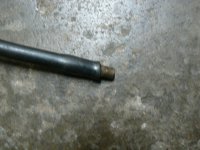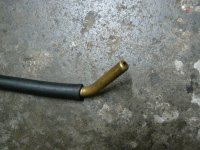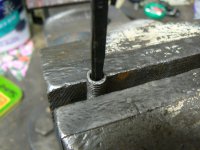Great guide koalar. So much useful stuff here. As both you and Dave mention, the plugs are angled but am I remembering correctly that two are slightly angled one way with the other two being angled the other? - I think Nos 1 & 3 go one way and 2 & 4 the other? Or maybe I'm confusing myself and thinking about another engine altogether? Using a solid extension is also the way I do it and this helps greatly with judging the angle.
Blowing dust and grit out of the hole before you remove the plug is, in my opinion, a must. I slacken the plug by about a half to one turn before doing this as I find it tends to loosen any grit which may have somewhat solidified around the sealing washer. Here's my "solution" for anyone not having a compressed air source, Like you, it's a variation on the pump theme:
I took a length of flexible tube and an old tyre valve, cut all the rubber off the tyre valve and forced it into the end of the tube:

The nozzle end is the spout of an old broken oil can, forced into the other end of the tube:

I think it has the advantage over your bike pump in that it leaves both my hands free to hold and direct the nozzle and maybe hold stuff, like leads etc, out of the way at the same time. Being lucky enough to now have a compressor, I tend to use compressed air but this old tool still gets used if I find myself working on one of the family vehicles away from home.
I also agree that it's a very good thing to keep the plugs in order of removal. You can tell a lot about cylinder condition and how fueling is from the look of a plug. However, as you say, many of the illustrations you find on the likes of you tube and google show old images which are useless with modern "super weak mixture" running engines. Probably the best simple thing to look for is that all plugs should look the same.
Like you. I've found the square section type eezi out to be the better option. For those who don't know what these things are here's some images, first off my box of various sizes I've collected over the years:
Here's a picture of the two basic types with a home made one on the left:

The one's I have are designed to work on normal right hand threads. To use you insert into the broken stud after drilling a hole down the middle of it:

Then give the end a few sharp taps with a hammer to make it bite into the stud. The flutes on the side of the tool bite into the stud so when you rotate the tool - with a tap wrench, spanner or whatever - it grips the stud and lets you wind it out. The problem with the reverse spiral type is that, as they grip, they wind themselves deeper into the hole. this seems a good idea when you first think about it because the more resistance offered by the seized stud, the deeper the tool will bit into the stud. This is good yes? Well, actually, no, because it also expands the thin wall of what remains of the seized stud which further locks it into the hole. The home made one is, as some will recognize, an old tap with the sides ground into a square section. Hammered into the hole it actually grips the stud quite well.
The problem with using these tools is that they are really quite brittle so if you've no experience of using them it's very difficult to judge when to stop applying more turning effort. Generally speaking my advice would be to stop trying to turn it any further if you feel it beginning to act like a spring. I find a sort of "cadence" application of force works well. Apply some force and immediately relax it then do it again and relax and keep repeating applying a little more turning effort each time until either the stud moves or the tool starts to act like a torsion spring. If it's "winding up" the tool then you're getting close to snapping it off - and you really don't want to do that as you're probably not going to deal with the result easily.
Having said all that I now a days prefer to weld a nut to the top of the broken stud if I can and leave the eezi outs in their tin! However, if we are talking specifically about plugs which have snapped off in the head (as we are here) then a square eezi out works.
If you need to clean damaged threads in the head then a back tap sounds a wonderful idea. I didn't even know they existed until very recently. I was taught to do this by applying a liberal coating of high melting point grease to the tap and then winding it in by only a couple of turns before removing it and wiping off the grease and trapped swarf, recoating, winding in a bit further, maybe four turns, and out again. clean off, recoat and back in a bit deeper. and so on and so on until the thread is cleaned up. The grease catches the swarf so really none drops into the cylinder. I've done many like this and never had a problem. Used the same procedure when cutting the threads for a helicoil and never had a problem with it. The secret is to only do a couple of turns each time so the swarf doesn't overwhelm the grease.





